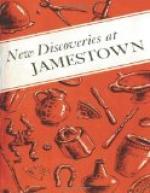[Illustration: Brewing beer at Jamestown. (Conjectural sketch by Sidney E. King.)]
DAIRYING AND CHEESEMAKING
Earthenware milk pans, bowls and pots, iron hoops (from wooden vessels), an earthenware funnel, and parts of skimmers, sieves, and ladles have been excavated. All these are evidence that dairying was an important household industry. This activity was usually carried on in a brick-paved room (with slatted windows) located on the northwest side of the house. Cheese, as well as butter, was probably made in the same room.
[Illustration: Lead and copper pipes, kettle fragments, A brass spigot, and other items found which may have been used for brewing or distilling purposes.]
BAKING
One of the largest objects that has been found is an earthenware baking oven, which was unearthed in an old ditch near the site of the May-Hartwell House. Restored from over 200 fragments, the oven was probably used between 1650 and 1690. It may have been made at Jamestown, molded of native clay and fired in a pottery kiln. In use, heated stones were placed inside the oven and left until the walls were hot enough for baking. Sometimes, however, the oven may have been placed directly on the embers of the fire. It undoubtedly was used out of doors, near a small house.
ASSOCIATED INDUSTRIES
A few artifacts that have been recovered are associated with millers, drapers, basketmakers, cutlers, tailors, barbers, netmakers, and glovers. These tradesmen usually worked in or near their homes.
[Illustration: Earthenware milk pan, brass ladle, funnel fragment, and other items found which relate to dairying and cheesemaking.]
[Illustration: Baking bread in an outdoor baking oven about 1650. (Conjectural sketch by Sidney E. King.)]
[Illustration: In this oven A Jamestown woman baked bread over 300 years ago. It appears to have been in use between 1650 and 1690.]
[Illustration: Jamestown soldiers carrying polearms (A halberd and A bill). (Conjectural sketch by Sidney E. King.)]




